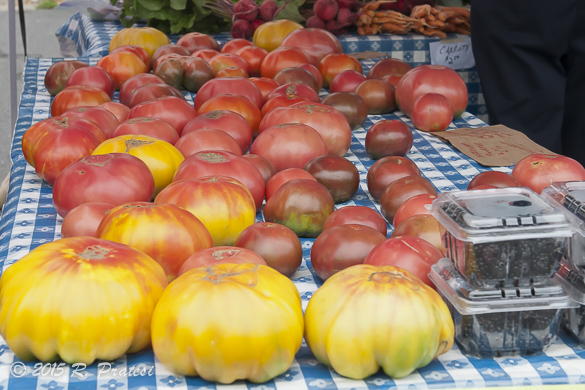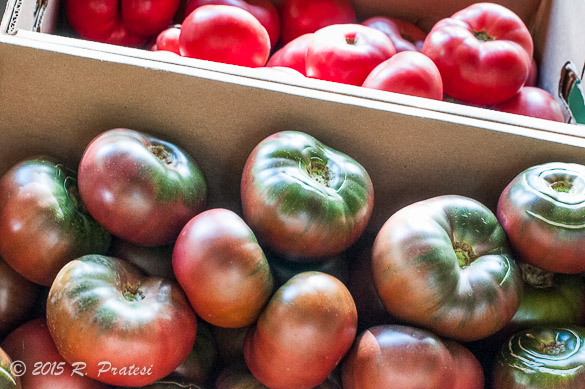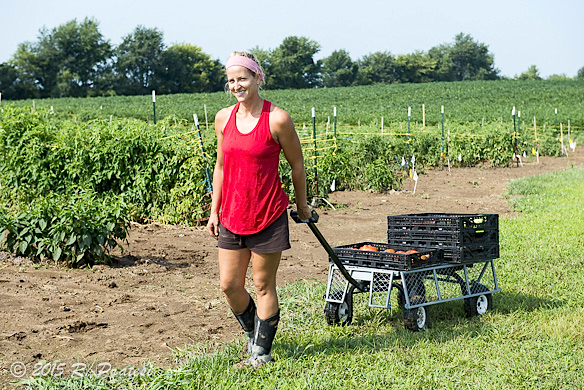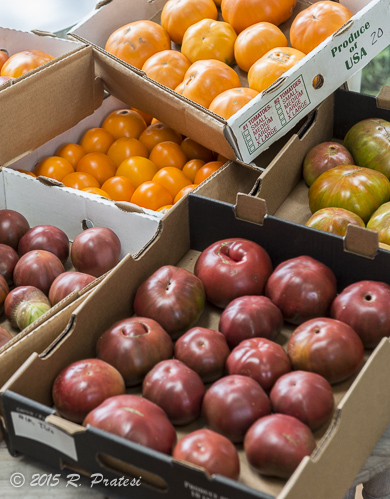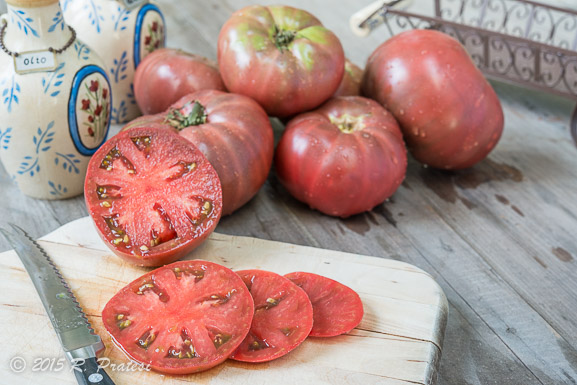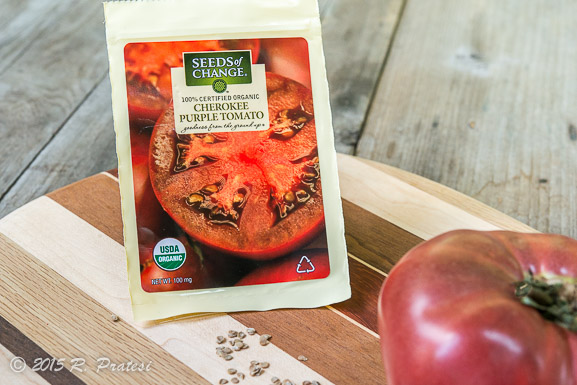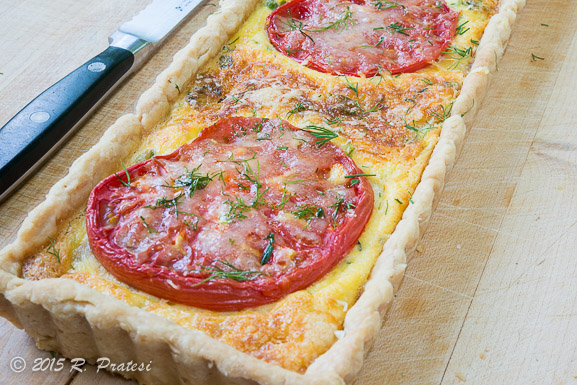Save the Flavors – Cherokee Purple Tomato and Vidalia Onion Tart
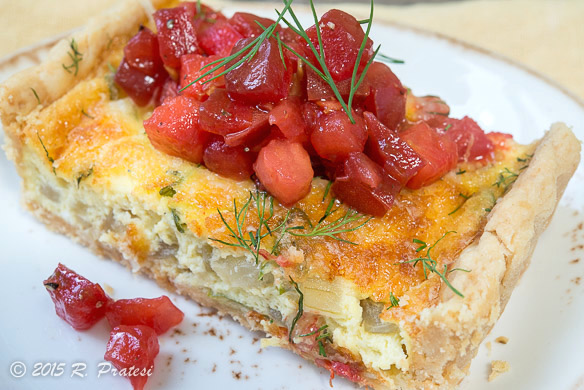
One of the things I love most about summer is the abundance of local fresh fruits and vegetables. Nothing says summer more than a fat, juicy, and ripe heirloom tomato simply sliced on a plate with a drizzle of olive oil and a sprinkle of kosher salt. It doesn’t get much better than that on a hot summer’s day.
Saturday in our city is market day, when the local farmers convene to share their bounty and there is no question that the tomato stand is a popular attraction. There on the table, mixed in with the yellows, oranges, and reds, is the prized catch. It’s a reddish-purple tomato (almost black) that is large, firm, and oh, so good. If you know what you’re looking for, it’s the Cherokee Purple Tomato.
I was recently contacted to work with Seeds of Change on a very important project focused on preserving heirloom flavors and ingredients. The first time I heard about their Save the Flavors campaign was when I received an invitation to attend a luncheon hosted by Chef Hugh Acheson (Five & Ten in Athens, Georgia and Empire State South in Atlanta.). I was excited when Seeds of Change contacted me again to be part of their campaign to help save the flavors of the Cherokee Purple Tomato. I’m pleased to take part in this mission, as we not only believe in saving the flavors of the past, we believe in the Cherokee Purple Tomato.
As you know, we have always supported local farmers and artisans and choose to shop at small markets where we can buy locally sourced ingredients, preferably organic. It’s important to us to keep these farmers in business so they can continue to grow many of the varieties of produce that have essentially been lost to commercial farming in our country due to the focus on cost, fast growth, transportability, and shelf life at the expense of flavor. If you’ve never tasted an heirloom tomato, such as the Cherokee Purple, and only buy hybrid tomatoes in a traditional supermarket, you are missing the bold, deep flavors that only an heirloom can deliver.
One farmer who we’ve worked with for several years, Brooke Eckmann of Ambrosia Farm in Finchville, Kentucky, chatted with me about her growing experience with this popular heirloom tomato. Brooke is one of the featured farmers in our cookbook with Chef Anthony Lamas, Southern Heat. An expert on growing heirloom tomatoes (she grows over 82 varieties!), she shared her thoughts with me on the Cherokee Purple Tomato.
“People love the Cherokee Purple. It’s always the first one to go at the farmers’ market, so sometimes I’ll hide some in the back and bring them forward throughout the day. It’s a “black” tomato and the closest flavor profile to it would be the Carbon, which is not quite as sweet and a bit savory. People love the Cherokee Purple because it’s so sweet, firm, and yet juicy. The Cherokee Purple plant is very good structurally. The plant itself is quite healthy and not subject to much disease. Some tomato varieties get squatty (which makes air flow through the plants difficult). Others are too long and leggy. Good structure helps prevent disease.”
Brooke went on to say, “When a plant is healthy it produces lots of fruit. My Cherokee Purple plants are loaded with fruit, big fruit. Many of the other blacks and stripes go straight to the trash because the fruit splits before it gets large enough to harvest. Compared to them, the Cherokee Purple is an angel. People who grow them know that and while other varieties are beautiful, this is a tomato that can be grown at home. Growing heirloom varieties require some special care, but when I eat a Cherokee Purple, it makes it all worthwhile.”
The history of a specific tomato plant is also important to Brooke and is one of the reasons she chooses to grow particular varieties. According to several sources, the Cherokee Purple Tomato originated with the Cherokee Indians who gave the seeds of this flavorful deep red and purple (almost black, hence the name “blacks”) to several Sevierville, Tennessee residents over a century ago. Over the years it made its way from Tennessee to other parts of the South and has become a Southern favorite.
While you can find this tomato at local farmers’ markets and specialty grocers in season, it is, as Brooke mentioned, one of the first tomatoes to disappear at market because of its flavor and texture profile. It is also an heirloom variety that is easier than others for people to grow at home. For those of you interested in growing your own tomato plants, Seeds of Change, the sponsor of the Save the Flavors campaign, sells packets of organic seeds for the Cherokee Purple Tomato.
During the month of July, many of their certified organic brands of rice and grain products will have a code to redeem for free packets of Cherokee Purple seeds. Founded over 25 years ago with the concept to preserve the flavors that are otherwise being lost to commercial farms and to give home gardeners and farmers access to organically grown seeds, Seeds of Change believes it’s more important than ever to support and develop sustainable community farming and gardening programs. In fact, a portion of their sales goes to support this initiative.
When you do source a Cherokee Purple Tomato, one of the best ways to eat it to truly savor the flavor is sliced and drizzled with a little olive oil and sprinkled with kosher salt. It you want to do something special that showcases the pure flavor of the tomato, but elevates it to something elegant and delicious, try this Cherokee Purple Tomato and Vidalia Onion Tart. With just a hint of heat and spice in this buttery crust and fresh herbs in the cheesy custard, the tart is a wonderful starter for a dinner party or a light entrée for a luncheon. Since Cherokee Purples are so delicious on their own, I amp up the featured flavor, the tomatoes, by topping the finished tart with a simple fresh tomato salsa. It is sure to impress and have your family and guests asking for the recipe. Of course, it’s the Cherokee Purple that’s the star of this dish, so you’ll have to tell them the whole story.
If you’ve worked with heirloom tomatoes in your cooking, you know they are juicy and can be watery, so they need to be salted and drained prior to adding them to certain dishes. I also dry them on paper towels before adding them to the tart to avoid any excess liquid. They are then added to the custard after it begins to set and then topped with additional grated cheese to finish baking.
While it may be too late grow your own tomatoes this year, make plans to grow the Cherokee Purple Tomato and other heirloom produce next year to help save these important foods and flavors. If you’d like to follow along with the Save the Flavors campaign, you can do so on Twitter @SeedsofChange and use the hashtag #SaveTheFlavors.
Enjoy!
* This post was sponsored by Seeds of Change. As with any sponsored article on our site, we only work with brands and foods we purchase and personally support.
This content is protected under International Copyright Laws. Bunkycooks provides this content to its readers for their personal use. No part (text or images) may be copied or reproduced, in whole or in part, without the express written permission of bunkycooks.com. All rights reserved.

Cherokee Purple Tomato and Vidalia Onion Tart
Ingredients:
For Pâte Brisée
- 1 ¼ cups all-purpose flour
- 1/8 teaspoon salt
- Pinch habanero powder, to taste
- 8 tablespoons cold butter, diced into ¼-inch pieces
- 2 to 3 tablespoons ice water
For Custard
- 3 to 4 slices Cherokee Purple Tomato
- Kosher salt
- ½ tablespoons butter
- ½ Vidalia onion, chopped
- 2 large eggs
- 1 large egg yolk
- ½ cup heavy cream
- ½ cup grated Gruyère cheese, plus more for tomatoes
- ½ teaspoon salt, plus more for cooking onion
- A few generous grinds of freshly ground black pepper
- 1 ½ teaspoons chopped fresh parsley
- ½ teaspoon chopped fresh thyme
- Snipped fresh dill, for garnish
For Tomato Salsa
- 1 Cherokee Purple Tomato, trimmed, seeded, and cut into ¼-inch dice
- Extra-virgin olive oil
- Kosher salt, to taste
- Freshly ground black pepper, to taste
Directions:
For Pâte Brisée
- Place the flour, salt, and habanero powder in a bowl of a food processor. Pulse to combine. Add butter pieces and pulse until mixture resembles coarse crumbs. With machine running, add ice water, a little at a time and pulse just until pastry begins to hold together. Remove the pastry and on a lightly floured surface, form into an oblong shape. If dough seems too sticky, sprinkle the pastry with a little additional flour. Wrap tightly in plastic wrap and refrigerate for at least an hour.
- On a lightly floured surface, carefully roll pastry out to a 6.5 x 16-inch rectangle and gently transfer to a 4.5 x 14-inch tart pan. Carefully press pastry into the pan and up the sides, folding back in the excess to create a sturdy side, also building it up a little higher than the pan to accommodate for less shrinkage. Prick the bottoms and sides of the shell and refrigerate for at least 20 minutes.
- Preheat a convection oven to 350 degrees. Line the shell loosely with heavy-duty foil, being sure to press into the edges, to avoid shrinkage while baking. Fill with baking weights or beans, making sure they fit into the corners.
- Bake 20 to 25 minutes until edges begin to brown. Remove crust from the oven and remove the foil and weights or beans. Continue baking crust for another 10 to 15 minutes, or until crust is light golden brown all over. Watch it carefully. Remove from the oven and place on a wire rack.
For Custard
- While tart crust is baking, place the tomato slices in a colander and sprinkle generously with kosher salt. Let stand, flip and salt lightly again to remove excess moisture.
- Melt butter in a medium skillet over medium-high heat and add in onion. Sprinkle lightly with kosher salt. Turn heat lower if necessary and sauté just until onion is translucent. Set aside. Whisk together eggs and egg yolks and stir in cream, cheese, salt, pepper, and herbs. Combine thoroughly and then fold in cooked onion. Pour into prepared tart pastry and bake at 350 degrees (convection) for 15 to 20 minutes, just until custard is beginning to set. While custard is baking, remove tomato slices from the colander and place on paper towels, drying well to remove any additional moisture. When custard is partially set, remove tart from oven and place drained and dried tomato slices evenly across the top of the custard. Sprinkle with additional Gruyère cheese and return to the oven to finish baking, 15 to 20 minutes more, checking after 15 minutes. Custard should be set, puffy, and lightly browned. If desired, place the tart under the broiler for a few seconds to lightly brown the cheese.
- Remove tart from the oven and place on a wire rack. Cool for 5 minutes or longer. Sprinkle with fresh dill.
For Tomato Salsa
- Place the chopped tomato in a small bowl and drizzle lightly with olive oil. Add in kosher salt and freshly ground pepper to taste. Combine well and taste for seasonings again as the juices released from the tomato may require additional salt or pepper. Serve immediately with the tart.
Original recipe by Gwen Pratesi / Bunkycooks.com
